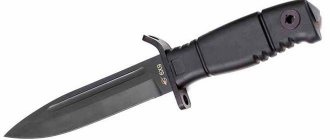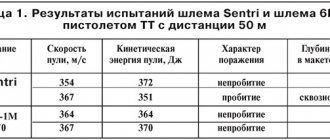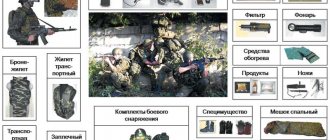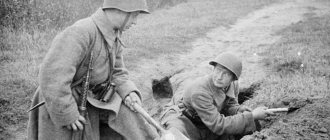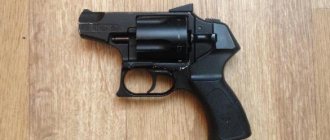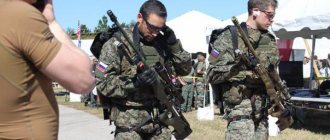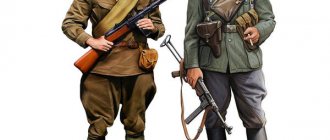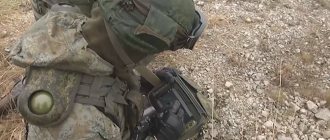Soldier of the future
The term “soldier of the future” has become firmly established in the media, and simply among people who are interested in military topics.
It is often understood as a kind of revolutionary concept designed to make military personnel almost “superheroes” of the battlefield. There is some truth in this: at least in terms of information awareness, the fighter of the future will indeed be several levels higher than the soldiers of past eras. We are talking, in particular, about augmented reality. And also the ability, through cameras, to see “through” the hulls of armored personnel carriers or infantry fighting vehicles in which the fighter is located. However, if we look at history, we will see that at all times there have been competitions in weapons and defense similar to modern ones. For the Middle Ages, for example, ringed armor was no less important than a good body armor for a modern fighter.
Some expensive cuirasses of the 17th century confidently withstood a pistol shot at point-blank range, and sometimes even a shot from an arquebus. Only muskets were guaranteed to penetrate such protection, which at the time of their appearance in the 16th century were very large and powerful examples of hand-held firearms, designed specifically to combat well-protected targets.
The First and Second World Wars revealed many new military concepts, but it is difficult to talk about a revolution in terms of protecting the soldier. During the Great Patriotic War, only relatively simple and cheap products could be used on a truly massive scale, such as the Soviet steel breastplate CH-42, which protected against pistol bullets and small fragments, but at the same time made it difficult to move on one’s belly. And we shouldn’t forget about the additional weight of 3.5 kilograms.
Features of the “Ratnik 3” exoskeleton
Outwardly, it will remind you of the lavishly painted image of a fighter of the future - this is the presence of a multi-layered, fine-mesh body armor, as well as massive angular elbow pads and a fully closed helmet.
Head
The main rule in developing such an element is its lightness. This allows you to avoid bending the fighter’s neck. It's bulletproof. There is also a mask with goggles that are greatly enhanced for less serious combat. The latter is usually considered to be a display screen containing information about intelligence and the soldier’s health, for example, his temperature. In addition, the watch also displays biological indicators and target information. The helmet was created with a breathing apparatus inside.
Weapon
Manufacturers made sure that the soldier's hands were not too loaded with equipment, otherwise this would reduce its effectiveness. Therefore, the only addition to the weapon was protection against fragments. In addition, there are watches that it protects from explosions. The latter are almost impossible to destroy.
Body
The fabric has only recently been developed. The material makes it possible to make the fighter elusive to infrared images, since all the heat is concentrated inside the kit. Such a vest cannot be penetrated by a bullet, which has been confirmed by repeated tests. With its use, most of the torso is protected. There are weak inserts in the armpits and below, in the abdominal area. The fabric and vest are fire and water resistant. Moreover, you yourself will be able to regulate the temperature of the suit, based on your own comfort and tactical considerations. The suit is suitable for areas with temperatures of 30-50 degrees.
Legs
Thanks to the presence of a titanium frame that works from boots to hips and in the waist area, it is possible to redistribute weight when you walk and run. This technology will increase your endurance and also allow you to increase your running speed. The battery is located in the boots. The latter are quite resistant to mines and fire. There is also full shatterproof protection for the legs.
“War is childish...”
Even the war in Vietnam made it clear: given the development of the media, it will no longer be possible to ignore losses, even if human resources provide such an opportunity. Now the killed soldiers and officers appeared before the audience on television, which invariably threatened the loss of the political rating of the current government. And in the long term there was a risk of defeat in the war.
Something needed to change. One of the results of the transition to professional armies of a new type was a sharp increase in the protection of a soldier on the battlefield. Moreover, every year the requirements for protection grew, which ultimately led to the emergence of such concepts as the American Land Warrior kit or the French FELIN.
FELIN / ©Defense News
The basis of the armor protection of the latter is a vest-unloading in the form of multi-layer fabric armor, onto which armor plates of combined armor with ceramics are hung. The helmet is based on organotextolite: the product itself has a built-in communication system and an optoelectronic system for processing and displaying information. Such default kits are very expensive and complex. The cost of FELIN, for example, is approximately 50 thousand dollars, but this is obviously far from the limit. And countries like the United States or China, which have the largest military budgets today, will continue to experiment with improving the protection of soldiers.
Land Warrior / ©Defense News
Electronics for a “smart” army
The main thing that brings Ratnik closer to the soldiers from science fiction films is, of course, the electronic filling. Here everything is run by “Sagittarius”, the reconnaissance, control and communications complex (KRUS), essentially a personal computer adapted for ease of use in reconnaissance and combat. The components of the complex with a total weight of 2.4 kg are distributed over a transport vest, the control device is in the hands of a fighter - a tablet. A more complex and functional tablet is used at the command post. Information exchange occurs continuously via a secure channel. The soldier can transmit text data, coordinates, photographs, videos. The commander on his tablet sees the location of all fighters, can coordinate their actions, plot routes, receive data on the enemy’s position, and much more. In this case, combat control resembles a computer game, and information and the speed of its transmission become the most important components of combat.
The Ratnik helmet has a universal mount on which various equipment can be attached, and it also integrates with KRUS and participates in the exchange of important information. The video module developed by the Central Research Institute “Cyclone” of the Rostec State Corporation, consisting of a sight and a helmet-mounted monitor, allows you to fire from cover. A variety of sighting systems and thermal imagers can also be used. The night vision system helps to fire in low visibility conditions.
The Ratnik's life and energy support systems include backpacks of various types, seasonal camouflage kits, a watch, a flashlight, a multi-tool knife, a mining shovel, a water filter, chemical protection and control equipment, first aid equipment, an autonomous heat source, a battery, and instruments for food, tent and sleeping bag. In total, “Ratnik” has more than 50 elements. The average service life of the kit is 5 years.
Russian field of experiments
The late Soviet “war machine,” having a fantastic number (at the time of the collapse of the USSR, there were 63 thousand main battle tanks in the army alone!), remained archaic in many respects. All the features of the Soviet army went to Russia, and the events of the First and Second Chechen Wars showed that something needed to be done. And the losses in the Five-Day War with Georgia, inadequate to the threat, made it clear that changes are required immediately. Later reforms were aimed, among other things, at the possibility of mass development of new, more complex technology, although they also did not proceed smoothly.
However, the first steps began to be taken earlier. Back in 1993, at the Military Council of the Ground Forces of the Russian Defense Ministry, the need for new equipment for soldiers was voiced. Clear objectives were formulated and preliminary cooperation was established. This is how the “Barmitsa” appeared, which can be considered the ancestor of the “Warrior” equipment - or even the “Warrior” of the zero generation. The Kalashnikov assault rifle or the new Abakan were considered as individual weapons, and the Zabralo body armor provided protection up to the fourth degree: that is, within the framework of the GOST that came into force in 2014, from machine gun cartridges of 5.45 and 7.62 millimeters caliber. In total, the new equipment included 50-60 elements, and the weight could reach 50 kilograms. Naturally, not all military personnel liked such a large weight, so the concept had to be revised. This is how the famous “Warrior” appeared.
“Barmitsa” / ©Star
All the king's men
Strictly speaking, “Ratnik” is not so much a single unified set as a direction of development, which is demonstrated by the appearance of actually several generations of equipment with the possibility of its addition in the future. According to the Commander-in-Chief of the Ground Forces Oleg Salyukov, as a result of the modification of the Ratnik, the weight of wearable equipment has already been reduced by almost one and a half times: from 34 to 24 kilograms. At first glance it seems that this is a lot, but it is incomparably less than the mass of the Barmitsa kit. Also, according to Salyukov, the effectiveness of the small arms included in the kit has increased approximately 1.2 times.
- The development of a new “soldier of the future” kit has begun in the Russian Federation
The Russian Federation is developing new equipment for the “soldier of the future.” It is likely that Ratnik-2 will enter service in 2025-30.naked-science.ru
In general, the early “Warrior” gradually grew into the second generation “Ratnik” now being supplied to the troops. And in the future, using the experience gained, they plan to create equipment that is more innovative in all respects. However, more on that later.
What is generally known about the new kit? The general designer of the “Ratnik” equipment was Vladimir Nikolaevich Lepin: in total, dozens of completely different enterprises of the military-industrial complex, such as TsNIItochmash and SARO Folding Knives, took part in the creation of the “future soldier kit”. For the first time, the “Ratnik” equipment was presented at the MAKS-2011 air show.
Military personnel of the Russian army / © RF Ministry of Defense
Using information from open sources, we can highlight several main aspects of the “Ratnik” combat equipment:
6B45. A single general-arms body armor with unified bulletproof armor panels of 5A protection class. They are designed to protect from bullets from the AK74 assault rifle and the SVD sniper rifle from a minimum distance.
The assault modification - 6B45-1 - has a class 6A protection level and theoretically allows you to protect vital organs from such powerful sniper rifles as the Accuracy International Arctic Warfare.
6B47. An armored helmet that provides head protection from Makarov pistol bullets from a distance of five meters and small fragments. The design is based on microfilament aramid threads. 6B45 provides the ability to mount a wide variety of equipment, which is important given modern realities.
6B49. A combat kit that partially protects the limbs and face from bullets, shrapnel and adverse weather conditions.
6B51. A kit that protects a soldier’s knee and elbow joints from impacts.
6B50. Safety glasses designed to protect the eyes from small fragments, hazardous chemicals, adverse weather conditions, and so on.
6Sh117. An unloading vest, which is designed for transporting individual combat and marching gear.
Control system "Sagittarius". It includes means of communication, target designation, information processing and identification. Essentially, “Sagittarius” is a wearable computer with peripherals distributed over an unloading vest. There is a tablet that acts as a digital compass with the ability to use digital maps.
GLONASS/GPS communicator. It determines the coordinates of fighters using satellite navigation systems.
Weapons and various sighting devices (we'll talk about this later).
©Riafan
In open sources you can find a detailed description of all the accessories of the “Warrior” kit, but you should not think that they are all available in full. “Ratnik is a fairly large list of property, equipment, communications, weapons and optics. And the equipment that can be issued, depending on the unit and subdivision, can be completely different. You shouldn’t think that if “Ratnik” was issued, then everything was issued: from the watch to the thermal imager. No, that's not true. Moreover, the elements pass through different services - communications, RAV, clothing, and so on. In addition, the kit is constantly being modernized, and, accordingly, the kits also differ in terms of delivery time,” said the Airborne Forces serviceman.
The kit, as one would expect due to its novelty, has many shortcomings that have been pointed out many times. “Metal zippers are made in such a wonderful way that they tear the fabric, they have to be finished with pliers,” writes serviceman Svyatoslav Golikov in the newspaper Vzglyad. However, don’t think that the Ratnik is a failed piece of equipment. We are talking more about “childhood diseases”. “Despite the excellent protective properties of combat equipment (“the helmet is excellent,” “the armor is very good”), the performance of a number of elements of the helmet and body armor leaves much to be desired,” adds the specialist.
- The Russian “soldier of the future” turned out to look like a computer game character
The Russian Technologies State Corporation presented a new concept of the Russian “soldier of the future.” According to Internet users, it is similar to the equipment of a fighter from the computer game Tom Clancy's Ghost Recon: ...naked-science.ru
It directly follows from this circumstance that many military personnel, according to their statements, are trying to replace some inconvenient/unreliable “native” components with something alternative. According to reports, fighters do not hesitate to exchange watches and multitools for new Chinese products, even if they also cannot guarantee reliability. Perhaps some problems can be eliminated in the future, making the Ratnik one of the best kits in its class.
Military personnel of the Russian army / © RF Ministry of Defense
However, no shortcomings even now prevent officials from the Ministry of Defense from calling the kit “the best in the world.” Here it is appropriate to touch on the topic of weapons, without which a soldier is not a soldier. Back in January 2018, it became known that the Ministry of Defense had adopted the Kalashnikov Ak-12 and Ak-15 assault rifles, as well as the AEK-971 and AEK-973. At the same time, it was the new Kalash that was chosen as the main army assault rifle, and the more expensive and complex AEK went to special forces units.
There is an important detail to consider. In fact, both the Ak-12 (5.45 millimeters) and the Ak-15 (7.62 millimeters) are the same Kalashnikov assault rifles as before, only with slightly modified ergonomics and an emphasis on the possibility of using different attachments: sighting devices, rangefinders, grenade launchers, flashlights. Let us add that previously, among the accessories for the “Ratnik” equipment, the 1P87 collimator sight, the 1PN138 night monocular, the 1P90 spotting scope and the 1K241 laser target designator were indicated. And also several types of thermal imaging sights: 1PN139 (large-caliber), 1PN140 (for normal observation) and a version for reconnaissance (unnamed). However, it is difficult to say whether the Ak-12/15 can be considered a modern assault rifle.
AK-12 / ©V. Kuzmin
The difficulties don't end there. The Russian Ministry of Defense has long set its sights on replacing the old Soviet SVD sniper rifle. For a long time, the ORSIS T-5000 complex was seen as an alternative. However, in 2022, the media reported that it was abandoned. However, there is also the SV-98, which has been modernized several times. And during the recent Pakistani-Russian exercises, Russian army snipers performed with British Accuracy International Arctic Warfare caliber .338 Lapua Magnum. There is nothing strange about this: creating a modern sniper system that would meet all the requirements is extremely difficult. Moreover, it is necessary to take into account that Western countries have occupied a leading place here for decades.
Orsis T-5000 / ©Wikipedia
Finally, let’s note the most important thing: the “Ratnik” kit over the years of operation has become familiar and in many respects “tried-in” equipment. In 2014-2015 alone, the Ministry of Defense received 71 thousand sets of “Ratnik” equipment. In 2017, serial deliveries of an improved version of the kit, the second generation of “Ratnik”, began to the Russian troops: by 2022, a total of 200 thousand such kits had been delivered to the army.
According to the general director of TsNIITochmash, Dmitry Semizorov, each set of equipment for the “soldier of the future” costs the Ministry of Defense approximately 200 thousand rubles. According to him, in this sense, “Ratnik” is preferable to more expensive Western analogues.

